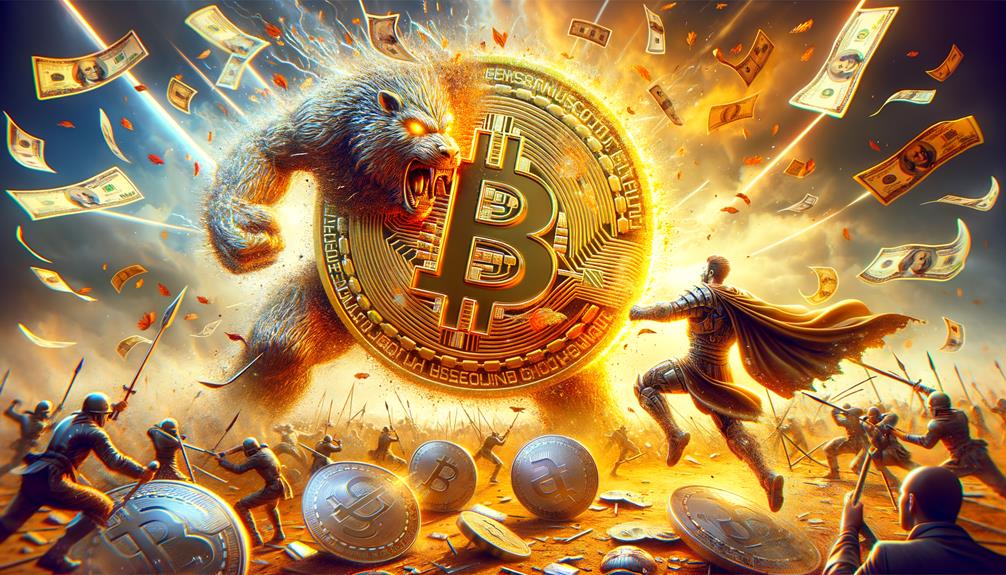The clash between gold and Bitcoin as coveted assets has illuminated a compelling narrative in the investment landscape, drawing attention to the divergent paths these stalwarts traverse.
While gold's historical resilience in times of economic turmoil has solidified its position, Bitcoin's disruptive foray into the financial landscape has stirred debates on the evolution of value preservation.
As investors navigate the intricate web of utility, liquidity, volatility, and regulatory considerations, the battle for supremacy between these assets reveals a multifaceted terrain where traditional might meets digital innovation, shaping the future of wealth preservation strategies.
Historical Significance of Gold and Bitcoin
The historical significance of gold and Bitcoin can be traced back to their divergent paths as a traditional store of value and an emerging digital asset, respectively. Gold has a rich historical evolution, revered for centuries as a symbol of wealth and stability. Its utility across industries has solidified its position as a reliable investment option, appealing to investors seeking a safe haven during market uncertainties.
On the other hand, Bitcoin's inception in 2009 marked a significant shift in investment psychology, challenging traditional notions of value and introducing a new era of decentralized currency. The volatile nature of Bitcoin reflects the evolving investment landscape, where risk appetite and technological advancements play vital roles in shaping market trends.
Market Performance During Pandemic
Amid the pandemic, the market performance of both gold and Bitcoin underwent notable fluctuations, reflecting the impact of global uncertainties on these assets.
Market trends during this period showcased contrasting behavior between the two assets. Gold, traditionally seen as a safe haven, experienced relative stability, aligning with its historical role as a hedge against market downturns.
On the other hand, Bitcoin's price surged, highlighting its potential as a more volatile yet rewarding investment option. Investor sentiment played a critical role in shaping these market dynamics, with risk appetite and perceptions of value driving decisions.
Understanding these shifts in market performance is essential for evaluating the resilience and adaptability of gold and Bitcoin within the context of a pandemic-induced economic landscape.
Utility and Diversification in Industries
During the pandemic-induced economic landscape, the utility and diversification of gold and Bitcoin across various industries play a pivotal role in shaping their distinct roles as assets in the market.
- Gold's diverse utility across industries enhances its stability.
- Bitcoin's primary use as a digital currency limits its industry applications.
- Industry advancements aim to expand the utility of Bitcoin in decentralized finance.
- Gold's established applications provide a solid foundation for investment stability amidst market fluctuations.
The utility expansion and industry applications of both assets underscore the importance of diversification for investors seeking a balanced portfolio. While gold maintains its position as a versatile asset with widespread industry use, Bitcoin's potential for utility expansion in emerging technologies may offer new investment opportunities in the future.
Liquidity Comparison and Investment Flexibility
In evaluating the comparative liquidity and investment flexibility between gold and Bitcoin, a nuanced analysis of market behavior and asset characteristics is imperative. Gold typically offers higher liquidity, allowing for quick portfolio reallocation compared to Bitcoin. The fluctuating liquidity of Bitcoin can impact investment decisions, particularly during market swings.
Gold's easier liquidation process makes it a more vital asset than Bitcoin, influencing investment choices based on liquidity considerations. Investment flexibility varies between the two assets, with gold being favored for its stability and ease of reallocation, while Bitcoin's liquidity challenges require a more cautious approach.
Understanding these liquidity differences is essential for investors seeking to balance liquidity and investment flexibility in their portfolios.
Volatility Analysis and Risk Evaluation
An in-depth analysis of the volatility levels and risk factors associated with Bitcoin and gold investments is important for making informed and strategic investment decisions.
- Volatility Trends: Bitcoin exhibits higher volatility compared to gold, with price fluctuations driven by market sentiment and speculative trading.
- Historical Data Analysis: Examining past price movements can provide insights into the risk levels associated with both assets over time.
- Risk Assessment Techniques: Utilizing metrics like standard deviation and beta can help investors evaluate the risk exposure of their portfolios to Bitcoin and gold.
- Diversification Strategies: Balancing portfolios with a mix of assets can help mitigate the risks posed by the volatility of Bitcoin and the stability of gold.
Role of Regulatory Environment in Investments
What impact does the regulatory environment have on shaping investment strategies in the domains of Bitcoin and gold? Government regulations play an important role in determining the investment landscape for both assets. Changes in regulations can greatly affect market stability and investor sentiment towards Bitcoin and gold. Understanding and staying informed about the regulatory environment is essential for making informed investment decisions. Let's explore further into the role of regulatory environment in investments through the table below:
| Regulatory Environment | Bitcoin Impact | Gold Impact |
|---|---|---|
| Strict Regulations | Decreased investor confidence | Increased demand for gold |
| Supportive Policies | Price stability for Bitcoin | Potential decrease in gold prices |
| Uncertain Environment | Higher volatility for Bitcoin | Safe-haven appeal of gold remains |
Analyzing these factors can provide valuable insights for investors navigating the dynamic regulatory landscape of Bitcoin and gold investments.
Capital Preservation Strategies: Gold Vs. Bitcoin
Comparing the capital preservation strategies of gold and Bitcoin reveals distinct characteristics that cater to different investor preferences and risk profiles.
- Historical Track Record: Gold has a centuries-long history as a reliable store of value, making it a traditional choice for wealth preservation strategies.
- Digital Preservation: Bitcoin, as a digital asset, offers unique advantages for those seeking modern solutions for wealth management, leveraging blockchain technology for secure transactions.
- Market Volatility: Gold tends to be more stable, suitable for conservative investors aiming for steady wealth preservation, while Bitcoin's price fluctuations can present opportunities for higher returns but also higher risks.
- Diversification Benefits: Combining gold and Bitcoin in a portfolio can offer a balanced approach to capital preservation, harnessing the strengths of both traditional and digital assets.
Emerging Trends in Financial Technology
The evolution of financial technology is reshaping traditional investment strategies and paving the way for innovative approaches to wealth management. Blockchain integration and cryptocurrency adoption are key trends driving this transformation.
Blockchain technology, known for its secure and transparent nature, is being integrated into various financial systems to enhance efficiency and security. Cryptocurrency adoption continues to grow, with digital assets like Bitcoin gaining recognition as alternative investment options.
These developments offer new avenues for investors to diversify their portfolios and explore opportunities beyond traditional assets. As financial technology continues to advance, incorporating blockchain and embracing cryptocurrencies can provide investors with access to new markets and potential sources of value creation.
Decentralized Finance and Asset Integration
The integration of decentralized finance and assets represents a cutting-edge evolution in modern financial systems, fostering innovative avenues for investment and wealth management.
- Blockchain Integration: DeFi platforms leverage blockchain technology to enable seamless transactions and smart contract functionalities.
- Enhanced Liquidity: Asset integration in DeFi ecosystems enhances liquidity, allowing for more efficient trading and investment opportunities.
- Risk Diversification: DeFi evolution enables investors to diversify their portfolios by integrating various assets, spreading risk exposure.
- Automated Asset Management: Smart contracts in DeFi systems automate asset management processes, reducing the need for intermediaries and enhancing transparency in transactions.
This integration not only streamlines asset management but also opens up new possibilities for investors seeking efficient and decentralized financial solutions.
Future Growth Prospects and Investment Strategies
Future growth prospects and investment strategies within the domain of decentralized finance and asset integration are critical considerations for savvy investors traveling the evolving landscape of modern financial systems.
When evaluating investment potential and growth opportunities, strategic asset allocation and risk management become paramount. Investors need to assess the long-term viability and potential returns of both gold and Bitcoin, considering factors like market trends, regulatory environments, and technological advancements.
Strategic asset allocation involves diversifying portfolios to mitigate risks and maximize returns, balancing traditional assets like gold with emerging digital currencies like Bitcoin. Effective risk management strategies are essential to navigate the inherent volatility of Bitcoin and the stability of gold, ensuring a well-rounded investment approach in the dynamic domain of decentralized finance.
Frequently Asked Questions
How Do Cultural Perceptions and Traditions Impact the Historical Significance of Gold and Bitcoin as Investment Assets?
Cultural perceptions and traditions influence the historical significance of gold and Bitcoin as investment assets. Gold's long-standing value is rooted in tradition, while Bitcoin's modern appeal reflects evolving attitudes towards digital currencies, impacting investment decisions.
What Role Do Geopolitical Events Play in Influencing the Market Performance of Gold and Bitcoin, Especially During Times of Crisis Such as the COVID-19 Pandemic?
Geopolitical events impact market performance of gold and bitcoin during crises like the COVID-19 pandemic. Understanding how cultural perceptions, regulatory changes, and global economic conditions interact with technology advancements is important for investors moving through investment decisions.
How Do Advancements in Technology Contribute to the Utility and Diversification of Industries Using Gold and Bitcoin Beyond Their Traditional Roles as Investment Assets?
Advancements in technology enhance the utility and diversification of gold and Bitcoin beyond investment roles. Technology innovations drive industry diversification, utility expansion, and investment innovation. These developments reshape traditional perceptions, creating new opportunities in diverse sectors.
What Factors Determine the Fluctuating Liquidity of Bitcoin Compared to the More Stable Liquidity of Gold, and How Does This Affect Investment Decision-Making?
Fluctuating liquidity in Bitcoin contrasts gold's stable liquidity, influencing investment decisions. Bitcoin's volatility, affected by market behavior, poses risks. Understanding liquidity dynamics is vital for strategic investment choices between these assets, balancing stability and potential returns.
External factors like global economic conditions and regulatory changes heavily impact the volatility and risk of investing in gold and Bitcoin. Investors must monitor these factors closely, analyze trends, and adapt strategies to navigate challenges effectively in both markets.
Conclusion
In the perpetual clash between gold and Bitcoin, the battle rages on as investors navigate the complexities of preserving capital and maximizing returns. While gold stands as the stalwart of traditional investment strategies, Bitcoin disrupts the status quo with its innovative approach.
As the tides of financial technology and decentralized finance continue to shape the landscape, the future remains uncertain. Will gold maintain its reign, or will Bitcoin ascend to new heights? Only time will tell.




